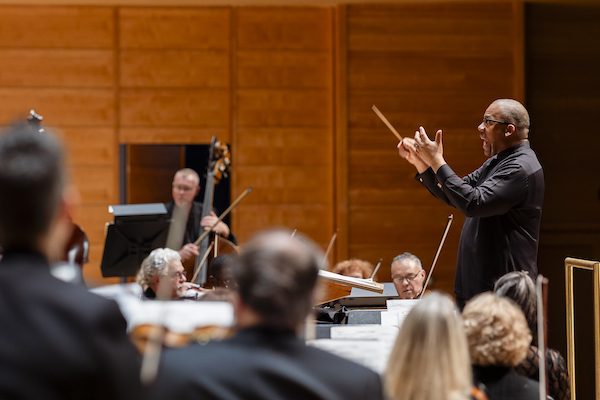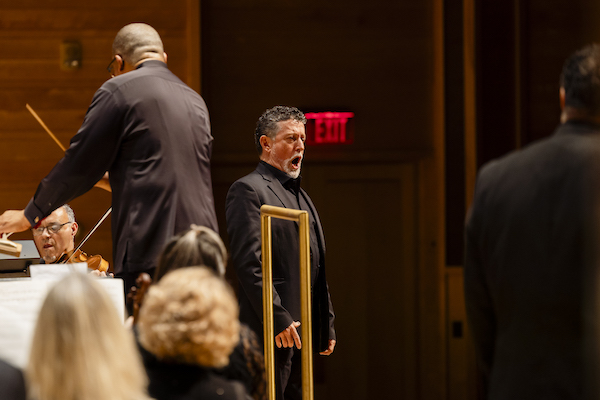Rogers, National Philharmonic make a rousing case for “Cantata Criolla”

Eugene Rogers conducted the National Philharmonic Orchestra and Washington Chorus Sunday in the Music Center at Strathmore. Photo: Elman Studio 2
The upside of classical music organizations opening up their repertoire to underrepresented composers is that audiences get to hear something new and different.
This was certainly the case with the concert given by the National Philharmonic and The Washington Chorus Sunday afternoon in the Music Center at Strathmore. The downside is that your regular audience may not turn out for things they do not recognize, also evident from the many empty seats.
A shame because the work on the second half of this concert, the Cantata Criolla by Antonio Estévez, was definitely worth hearing. The Venezuelan composer, who died in 1988, premiered this choral work in 1954, a few years before his country became a democracy again (and before the disastrous socialist government established by Hugo Chávez and continued by Nicolás Maduro). The text is equally famous in Venezuela, a poem by Alberto Arvelo Torrealba called “Florentino el que cantó con el Diablo.”
Written in 1940, the poem had its origins in folk legends from the Venezuelan llano, or plain. The choir serves as narrator of the opening section, in which the devil meets a man named Florentino as he rides toward a town. Florentino accepts the challenge, setting up the folk song known in Venezuela as the joropo, a form that often involved dueling back and forth in competition. Estévez gives the dialogue section to two soloists, a baritone for the devil and a tenor for the triumphant hero, after which the chorus returns to help send the loser back to hell.
Estévez set the tone of the work with an austere opening, slow in tempo and marked by loud drums. Piano, harp, and double-basses take over in softer music, as the chorus describes Florentino the bard riding along one evening on the plains. In a cinematic touch, strikes on a wood block evoked the clip-clop of his horse’s hooves. After a disturbing experience where he is unable to take up water from a creek, only sand, the devil rides up to the sound of whip cracks.

Baritone Juan Tomás Martínez was a soloist in Estévez’s Cantata Criolla. Photo: Elman Studio 2
The singers walked to either side of the conductor’s podium to sing their parts. As the devil, Venezuelan baritone Juan Tomás Martínez Yépez seemed more at ease of the two soloists, singing from memory in his native Spanish, and with stylistic authenticity. His stentorian voice filled the auditorium impressively as he sang the complex lines, often overladen with folk-like polyrhythms. Along with the crisply articulated choral portions, with generally fine Spanish diction, this strong performance made a striking case for a lesser-known work.
Tenor Scott Piper, reading from a score, was less assured as Florentino. The crucial high notes were all there, but some scratchiness crept into the voice here and there. In particular, the rhythmic complexity of the work did not come out as idiomatically. Part of this was due to the otherwise skilful conducting of Eugene Rogers, artistic director of The Washington Chorus, whose gestures leaned toward overly detailed rather than allowing a more natural groove.
The style of the work might be described as Carl Orff with maracas. Insistently repeated notes, like Gregorian psalmody, permeate the piece as do atavistic driving rhythms recalling Orff’s Carmina Burana. The part for male choir, as the devil appears in the door of the humble ranch where Florentino has stopped for the night, echoed similar writing for male choir in the “In Taberna” sequence of Orff’s celebrated work.
The choir took their seats as the song duel began. Estévez quoted from two famous Gregorian chants in the orchestra and choir parts, associating the devil with the “Dies Irae,” the sequence from the Requiem Mass. The Marian antiphon “Ave maris stella” appeared at the end, as Florentino ends the contest, victoriously calling on the intercession of the Virgin Mary, taken up by the chorus in a litany of names for the Virgin.
The concert opened less successfully with a performance of Breaths of Universal Longings, a choral piece premiered last year by Michigan-born composer James Lee III. Commissioned for the 150th anniversary of the Cincinnati May Festival, where it was premiered, the piece is a celebration of joy in singing, especially as that activity was resurrected in the wake of the coronavirus pandemic.
In the four movements, Lee set his own paraphrases of Biblical verses about creation and the song of creation, as well as words by African-American poet Charles Bertram Johnson and the Welsh “vagrant” poet William Henry Davies. In the least inspired choice, he used words created by the members of the May Festival Youth Chorus in the third movement. Young people from the Reservoir High School Chamber Choir sang the youth chorus parts beautifully in this concert.
Lee’s music traded largely on cliches, with the choral parts amassed into dissonant clusters that then resolved into saccharine harmonies, the texture dusted with folksy tambourine and an absurd overuse of bar chimes for wistful effect.
Rogers was effective conducting this work, which is much more rhythmically straightforward, and the huge chorus produced massive walls of sound, sometimes stretching the sopranos to shrillness in the highest range. The ending, with brass fanfares and multi-metric dance rhythms, felt even more conventional.
The National Philharmonic partners with the Baltimore Choral Arts Society for its annual performances of Handel’s Messiah December 16 to 20. nationalphilharmonic.org
